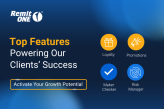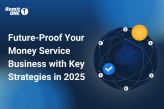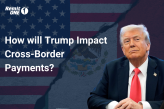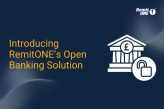Categories
Video: The Digital Payments Boom – How to profit? September 14, 2021

Continuing our recent discussions exploring some of the challenges and opportunities being faced by the remittance sector in these uncertain times, RemitONE hosted a webinar on the 24th of June 2021 regarding the digital payments boom that has come as a result of the COVID-19 pandemic and the rise of open banking. The panel was made up of experts from both RemitONE and our friends and partners in other global companies. In case you missed the webinar, here is a summary of the key insights.
Webinar moderator:
Ziad Mannan, Head of Engineering at RemitONE
Panellists:
- Walter D’Cruz, Director at Moneo Solutions and CEO at Livil Ltd
- Nadeem Qureshi, Chief Technology Officer at USI Money
- Mahmood Kamran, Managing Director at EToro
- Damien Cahill, Chief Operating Officer at Vyne
We’ve seen a lot of drastic changes in the payments industry in the last five to six years, particularly in the area of repayments or wallet payments. What have been the main developments in this industry?
Walter: There are certainly a lot more choices out there that have sprung up over the last five or six years, whether that’s faster payments, open banking or blockchain. One major development that I’ve noticed personally is in compliance. Although it can be a bit of a logistical headache, it is fundamentally important to all of our businesses. Because without compliance, there is no business. Technology, meanwhile, is being led by the fintech industry so it’s important that everyone else in the sector pays attention to what they are up to so they don’t get left behind.
Mahmood: The past five years have been great for the payments industry by and large, particularly in the past two years as COVID acted as a catalyst that forced payments to become digital, even in markets that were dragging their feet. Digital adoption rates have gone up by 200% and eToro saw 800% growth as businesses began moving to contactless payments. The pandemic fundamentally changed the way customers behave, the way we perceive threats and risk and how we adapt to operational challenges.
What is open banking and how does it work?
Damien: What open banking essentially does is remove all of the potential failure or friction points in open accounts and open payments. Because, at the end of the day, a card is nothing but a passport to a bank account, and all the stuff in between is border control. The Payment Service Directive 2 (PSD2), is a pretty wide-ranging piece of legislation, a piece of which essentially asks the banks to open their doors to tech companies and let them stack account information providers and payment initiation providers. It’s fairer because the cost is reduced, the controls applied by card providers are removed, the success rate is higher and most fraud aspects are removed because there are no 16 digits out there in the ether. It’s a bank-level transaction with biometric authentication that is married to the bank’s data and app. So it’s more or less 100% secure.
In what ways can instant payments become a factor for competitiveness and differentiation?
Nadeem: The objective at the moment is to achieve a real-time settlement environment. The fintech industry is moving so fast that you have to stay ahead by retaining your existing clients. One of the things driving this push is customer expectation as everyone wants access to their funds and in this regard PSD2, has created a legacy issue that we’ll probably continue to see develop over the next five years. Overall, however, not only do instant payments reduce risk, but they enhance things like reporting and onboarding too. In the supply chain, meanwhile, there is ample opportunity for new players to enter the space. For institutions though, any competitiveness is going to mean evaluating tech and reassessing functionalities such as the onboarding experience. It’s a growing trend that we’re only just seeing the impact of.
What are the implications that instant payments by open banking will have on the existing money transfer infrastructure?
Nadeem: In terms of positive implications, using open banking APIs would allow us to create a more level playing field with the older established banks. Open banking allows us to use secure channels effectively and gives the consumer a better understanding of their finances and a greater degree of flexibility. It also not only leads to new client acquisition but ensures we retain existing clients through cross-selling opportunities, forcing us to increase scalability and digitalisation. Every day we see innovations and PSD2 has opened unimaginable doors for us. Over the next few years, we will really start to see these functionalities being utilised. You may see the decline of cash and cards and people won’t want to even carry a physical card anymore, just a phone. It’s the one thing you don’t want to forget when you go out.
Can MSBs build more profitable client relationships by leveraging instant payments and open banking?
Walter: The formula hasn’t really changed. Instant payments are instant payments, the cost base is going to be the same across the base, as is the SLA. Personally, I foresee the growth of subscription-type models as there’s no other way you can build profitability in a market that has shrinking margins and increasing compliance costs. Subscription models are incredibly efficient, as if you’re paying someone each month, you’re more committed to using it as opposed to downloading competitor apps. The cost of customer acquisition isn’t decreasing either. You have to be innovative in how you bring customers in ahead of regulation and competitors. You can’t afford to sit back.
How are instant payments being positioned in the Middle East and Africa? Are they being positioned as the new normal, or premium services and what can MSPs do to set their offerings apart from those of the others?
Mahmood: What was once the premium is now the new normal. So now, with each transaction you’re always asking yourself “why does it need to take 3 to 5 days, why can’t it be instant?” This is always at the back of our minds. If a bank is not ready, such as in developing countries that are still working on legacy systems, they will be taken over by the new technology providers with the means to bring them into the modern age. We’ve seen this in the middle east as well. Banks need to catch up to this regime. The Singapore and Malaysian banks have adopted fast payment systems similar to what we see in the UK but the central banks in the middle east really need to start catching up.
When you’re looking at a payment gateway or provider, what are the critical questions to ask when evaluating a provider?
Nadeem: The key areas are reliability, settlement times and transactional cost. It’s best to go through recommendations too. Sometimes we don’t pay attention to the various card types and settlement fees but these are big issues if you’re a high turnover business. For example, you may realise your 0.2% became 0.4% because you didn’t factor in X, Y and Z. Look at the term of the contract for flexibility too. In such a fast-growing industry I would not want to tie myself up in a 2-year contract. Big innovations are happening. We also need to look at the merchant experience, the types of ports, the efficiency and the support. It’s these small areas that we sometimes tend to miss that are actually often the most important.
How does fraud play a challenge to instant payment – does faster payment mean faster fraud?
Damien: I don’t think it means faster fraud. Quite the opposite actually. Fraudsters will always try to penetrate systems, that’s what they do. But with the strong customer authentication that’s been brought in now, it’s no longer acceptable for the consumer to just have 16 digits and the expiry date, they’ve got to have two out of three prescribed things – something you are, something you have and something you know. For example, OTP (one-time passcodes). If you look at the way Vyne is set up, the transaction initiates through biometric ID into the banking app. It would be very difficult to defraud that system because your face or thumbprint is more secure than having 16 digits flying around. The way fraudsters work with card payments is they execute phishing attacks to get you to verify your card details. They’ll obtain tens of thousands of details and then run velocity check transactions with one pound to a charity if it goes through, then they start spending money with a remittance company or a retailer. You can’t phish attack those bank account things because it’s a closed loop. You can’t phish attack thumbprints or face ID.
What about the impact on profits? What will we see if we throw digital currency and blockchain into the mix?
Walter: I think you’ll see an increase in profits and the cost of compliance will definitely go down. As long you’ve got an efficient office and a way to connect to your partners then you’re always going to be ahead of the game as opposed to being stuck with a legacy system that takes forever to change or route to a different payment channel.
Mahmood: Cryptocurrency is going to continue to evolve as a method of payment. Visa recently launched their product which is based on USDC, a stable coin. They’re planning on doing the same for GBP and Eurostable coin and they’re looking for partners to initiate this. This becomes a settlement currency and represents the evolution of what digital currency will look like in the future. It’s interesting, 6 years ago I thought this was all a scam, now I’m saying it’s the future. It’s evolution.
What’s next, what’s coming up, what should we expect to see in this space in the next few years?
Mahmood: I believe you will see increased use of digital wallets and the way digital wallets are used. The behavioural change will happen. In fact, it’s happening now. A key player in this landscape, mainly for UK and Europe, is strong customer authentication, particularly biometric authentication. Strong customer authentication will be implemented as every cardholder and every merchant has to comply with this rule, and you’ll see that this makes a big change in the way by which digital payments will happen in the next twelve months. I also see cross border payments becoming more popular.
Walter: I want to talk a bit more about embedded finance services in markets like Africa, where the app will have the ability to get some micro-financing to finance lives on a smaller level. That’s definitely going to be driven by blockchain. I also think there’s going to be a lot of consolidation. Everyone is into it right now, and if you look at it historically, this isn’t a “fad” or a “trend” anymore – it’s a fact of life. In terms of crypto, you’ll see stable coins being a part of the central bank digital currency world. So settlement and liquidity for cross border payments will be instant. You’ll also see cryptos take different roles in terms of regulation. I don’t expect global consistency anytime soon though. That’s going to take a lot of time and a lot of trial and error.
Nadeem: There are the things we’re predicting, and things we’d like to see and there’s a lot of excitement and worry (on a technical level) when it comes to how we’re going to achieve these things. Personally, I think we’ll see great strides being made in the onboarding experience. Whether it’s by using open banking APIs or some other innovative tool, in terms of consumer experience, logging in and making a transaction will be extremely fluid. A lot of changes are going to happen but nobody can really predict how things will be in twelve months, at least not 100%. The generic product will be the same but the execution might be completely different.
Damien: A lot of things. Everyone said 2020 was the year for open banking. But it wasn’t. 2021 is the year of merchant adoption and 2022 will be the same but with more of an uptick of consumers getting involved in cryptocurrency and open banking, the adoption rates for which have been massive. It’s easy to see why too – they make the world of payments far easier for consumers and merchants alike – for operation and efficiency on the merchant’s side and for organising digital life for the consumers. It makes your business measurably better. Honestly, my message is adapt or die, crypto is the new technology, like it or not, it’s here to stay. There’s no stopping innovation.
Our thanks to Damien, Mahmood, Walter and Nadeem for their words and their time.
What next?
Now that you’ve read our article we want to help you get the most out of it and deep dive into the trends and predictions shared.
Tap into our experts and schedule a free 30min consultation.
Related Posts
-

Power Up Your Platform: The Top RemitONE Features Driving Our Clients’ Success
What if the growth you’re chasing is already built into your system? If you’re using the RemitONE Money Transfer Platform,…
July 9, 2025 -

Episode 1: Trump’s Threats to Cross-Border Payments – What It Means for Your Money Service Business
Donald Trump’s return to office has reignited policy debates, with ripple effects already reaching the cross-border payments space. From remittance…
July 9, 2025 -

How to Build a Leaner, Smarter Money Service Business in 2025
In an era of rapid regulatory change, rising customer expectations, and digital disruption, how can money service businesses (MSBs)—companies that…
May 22, 2025 -

Trump’s Threats to Cross-Border Payments: What It Means for Your Business
It’s been a short while since Trump stormed back into office, and he’s already shaken things up with his hard-hitting…
May 22, 2025 -

Unlock Faster, More Secure Payments with RemitONE’s Open Banking Solution
We’re excited to introduce the latest enhancement to our RemitONE Money Transfer Platform: the RemitONE Open Banking Solution. Competitively priced…
January 31, 2025 -

How to Expand Your SEND Operations in the UK and Europe—Without the Regulatory Hassle
The remittance market in Europe is valued at €133.7 billion annually, with the UK market contributing an additional £23 billion.
January 31, 2025